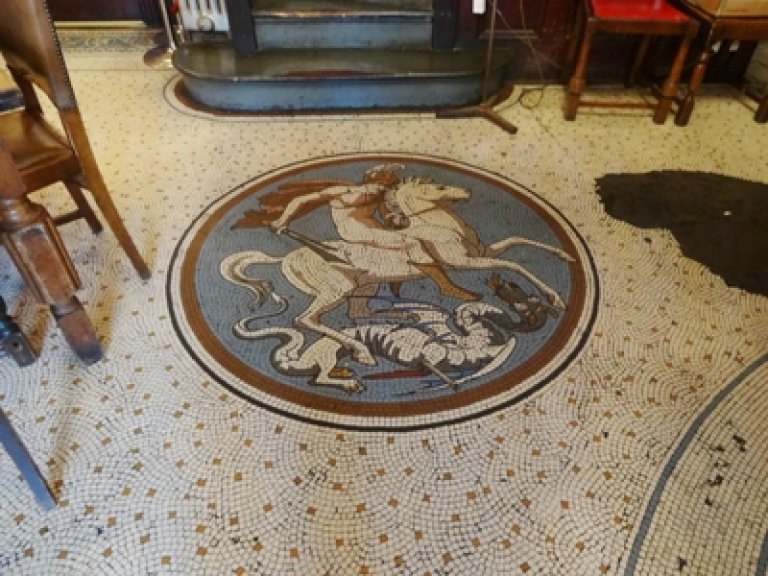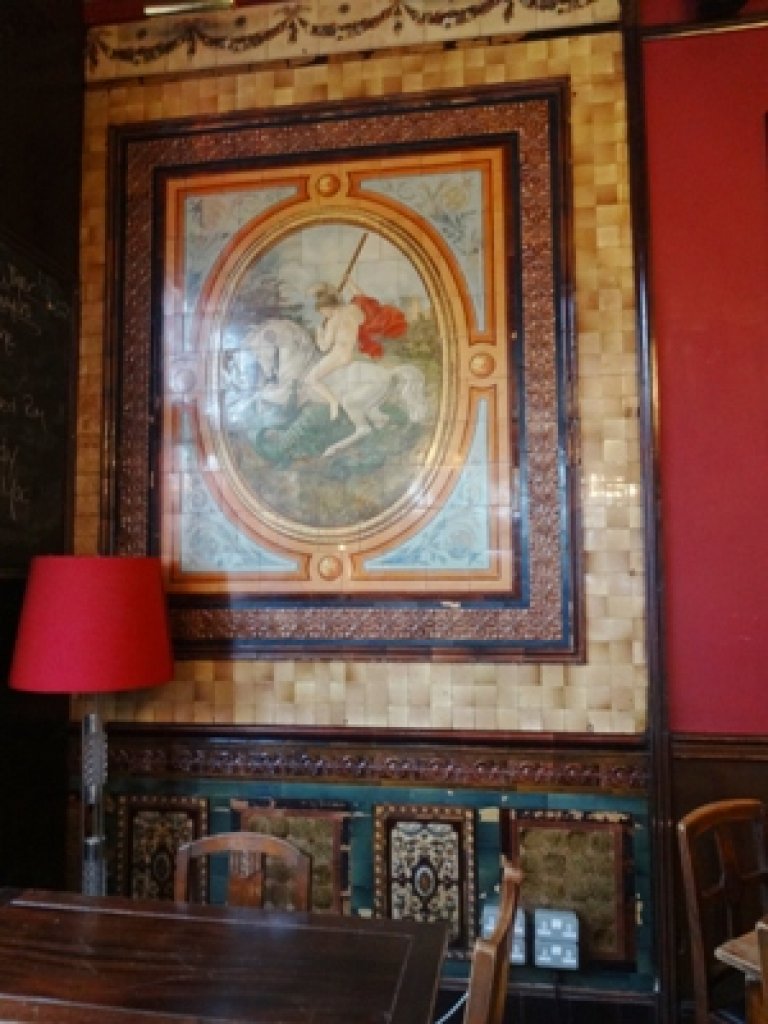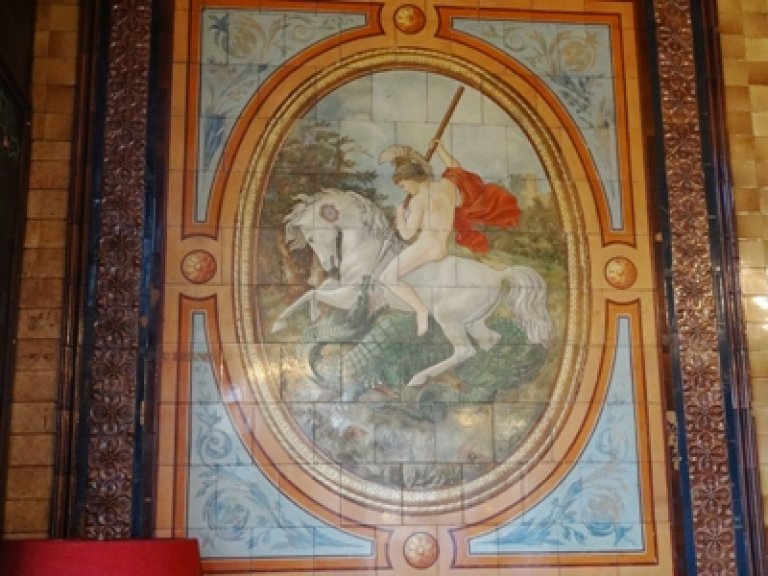Peasant
240 St John StreetFinsbury
EC1V 4PH
This pub is not only a grade II listed building, it is also a Two Star pub on the Campaign for Real Ale’s (CAMRA) National Inventory with an interior of very special national historic interest, and the description is as follows: "Three-storey pub of red brick rebuilt 1889-90 to the design of H.J. Newton. The ground floor has a timber pub front, granite dado, pedimented entrances with richly ornamented tympana and spandrels. At the top of the building is a balustraded parapet; also central semi-circular pediment to west and north elevation. The pediments have dormers with round-headed windows and stone relief decoration with roundels bearing the figure of St George. Corner bay surmounted by dormer.
The decorative mosaic floor indicates the pub was originally divided into seven distinct compartments separated by partitions. There were originally four exterior doors. The mosaic floor indicates that off the former lobby/passage on the left there were two snugs at the rear. Also, there were two snugs to the right of the present entrance. The room on the rear right has changed – the mosaic floor indicates a new wall has been added to create a passage at the rear of the pub. The decorative mosaic by the right-hand door includes a dragon, grapes etc.
From the front left-hand door a lobby created by a partition ran to the rear. As you enter there is a decorative ‘THE GEORGE AND DRAGON' in mosaic. The left hand wall has floor to ceiling tiling including a splendid multi-coloured large tiled painting depicting St George slaying the dragon with a relief-pattern tiled dado below by Webb and Company of 94 Euston Road. If you take a close look at the horse's head you will see a rosette and around it a cracked tile - this is damage from shrapnel in WWII and the rosette painted on to cover it up. The tiling may continue beneath modern timber dado to rear. At the rear near the staircase to the first floor the mosaic tile floor also incorporates a St George slaying the dragon scene. Above the left hand side there is a fibrous plaster ceiling of intersecting circles and what looks like a skylight.
The original curved bar counter survives in its original position apart from a small straight section on the right-hand side, as indicated by the mosic floor. Here there is a modern replacement which is very similar in style. The original bar-back fitting has been retained. Behind the bar back fitting there is the original Publican's Office with the door on the far left of the servery – the mosaic floor indicates there have been no changes to the layout. The mosaic floor also confirms that the present corner vestibule entrance is a later addition.
The upstairs bare wood floored dining room has a bar back where the lower part looks modern but the upper part is an elegant mirrored fitting with glass shelves and possibly imported. There is a largish metal fireplace with old fireback and a decorative plaster cornice."
The listing description is as follows: "The Peasant (formerly The George and Dragon) public house. Public House (No. 240) and former dining rooms (No. 238), the latter now offices. Rebuilt c1889-90 to the design of H J Newton, on the site of an earlier pub with some late-C20 modification.
MATERIALS: Red rubbed brick with moulded brick and terracotta decoration; painted stone dressings; timber pub front with cast-iron decoration; granite plinth; slate roof.
PLAN: Building occupies splayed corner site. 3 storeys high plus basement and attic. 2 bays to north, 1 bay to corner, 3 bays to south. Ground-floor pub interior now open-plan. First floor has large function room, now a restaurant.
EXTERIOR: Both the pub and former dining rooms are treated as single composition. West elevation to St John Street of 3 bays with entrance to office in south bay and central pub entrance; further entrances to NW corner and east bay of north elevation. Pilastered pub front has pedimented entrances with richly ornamented tympana and spandrels and cast-iron decoration to window heads. Upper lights to windows and entrance fanlights have patterned glazing with bevelled glass. Above ground floor, bays divided by pilasters; paired windows with string-course above and decorative terracotta panels of floral ornament. Window arches of gauged bricks with rounded lower edges forming scalloped effect; decorative terracotta keystones. Moulded stone cornice between first and second floors. Moulded stone cornice and balustraded parapet; central semi-circular pediment to west elevation and matching pediment to east bay of north elevation. Pediments have dormers with round-headed windows and stone relief decoration with roundel bearing figure of St George. Corner bay surmounted by dormer set in aedicule with clock and weathervane. Timber sash windows; those to first floor with additional top-hung pivoting upper lights. Slated mansard roof; decorative iron cresting to No. 238. Moulded brick chimney stacks.
INTERIOR: Ground floor pub retains central curved bar, altered at west end. Bar back with glazed patterned fanlights. Decorative mosaic floor throughout, with original pub name 'THE GEORGE AND DRAGON' in former lobby area to NE entrance. Coloured tiled panel to left of this entrance depicts St George slaying the dragon, restored after WWII bomb damage; relief-pattern tiled dado below, which may continue beneath modern timber dado to rear, the mosaic tile floor also incorporates a St George slaying the dragon scene. Fibrous plaster ceiling of intersecting circles to east part of bar. Stair on rear (south) wall with turned balusters. First-floor restaurant has decorative plaster cornice and window architraves decorated with paterae. Second floor not inspected. Interior of No. 238 not inspected but is known to be much altered at ground floor.
HISTORY: Originally called The George and Dragon, the pub was rebuilt and enlarged c1889-90 on the site of an earlier pub of the same name, which had once been called The Green Dragon. The 1893 the Post Office directory lists No. 238 as dining rooms run by Charles Cousins and No. 240 as The George and Dragon, run by Charles Taylor. Although No. 238 was designed as a unified composition with No. 240 (see below), it appears always to have been in separate ownership.
SUMMARY OF IMPORTANCE: A handsome, well-detailed example of a late C19 public house with high-quality brickwork, a good pub front and some original internal pub fittings and decoration of note. No. 238, although altered internally, is an integral part of the design and is included principally on the grounds of external architectural interest.
SOURCES: B Cherry and N Pevsner, The Buildings of England, London 4: North, p 630; Islington Local History Centre"
The WhatPub link is here: WhatPub/Peasant
The Pub Heritage Group link is here: PHG/Peasant
The Peasant has yet to feature on a LPG pub tour.




